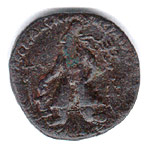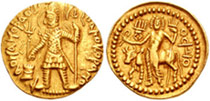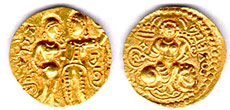 The Kushanas came to India in the first century A.D. They belonged to Yuch-chi tribe in China. They moved towards the west. Kujula Kadphises, a Yuch-Chi chief, had established himself in Kabul and Kashmir. He founded the Kushana dynasty. His son Vima Kadphises was also famous and issued the first gold coins of India. They resembled Indian coins. Kushana Empire covered north west of India (includes Pakistan and modern Afganistan) and northern India. Ample evidences of trade with China, central Asia, Egypt and Rome are available which made their economy very strong and kingdom wealthy and prosperous.
The Kushanas came to India in the first century A.D. They belonged to Yuch-chi tribe in China. They moved towards the west. Kujula Kadphises, a Yuch-Chi chief, had established himself in Kabul and Kashmir. He founded the Kushana dynasty. His son Vima Kadphises was also famous and issued the first gold coins of India. They resembled Indian coins. Kushana Empire covered north west of India (includes Pakistan and modern Afganistan) and northern India. Ample evidences of trade with China, central Asia, Egypt and Rome are available which made their economy very strong and kingdom wealthy and prosperous.
 The Kushana coins reveal a great deal about the rulers of that time. Undoubtedly, all the Kushana coins were used as a media to propagate the Kings superiority. The concept of showing king or the ruler on the coins was non-existent in India and all the previous dynasties minted coins showing only the symbols (called as the punch marked coins). It was the Kushana rulers who popularized this idea, which remained in use for another 2000 years. Kushana coinage was copied not only by later Indian dynasties like the Guptas, but also by the neighboring kings like Sassanians (of Persia). They reveal how the images of kings wished to be seen, and the religious practice. Coins were the carriers for official propaganda of greatness of Kings and deities of the empire. Kushanas devised their coins with various Gods of culturally, ethnically diverse population of the empire. It is evident through Kanishka`s coins, which carried images of Buddha in several poses, that he had been a great patron of Mahayana Buddhism. Vasudeva`s coins reveal that he is a convert to Hinduism and a devotee of Mahisvara (Oesho). The motif of the shoulder fire on Vima, Vasudeva-I, Huvishka and Kanishka-I coins, symbolizes the super natural power of the kings (connection with Athso - the Fire God). Huvishka stuck coins with Greek, Hindu, Zoroastrian and Bactrian deities (Pidti, Ardochsho, Miiro, Oado). Some of his rare coin issue shows Goddesses Uma (Ommo in Bactrian) and Simhavahini Durga with her vehicle Lion.
The Kushana coins reveal a great deal about the rulers of that time. Undoubtedly, all the Kushana coins were used as a media to propagate the Kings superiority. The concept of showing king or the ruler on the coins was non-existent in India and all the previous dynasties minted coins showing only the symbols (called as the punch marked coins). It was the Kushana rulers who popularized this idea, which remained in use for another 2000 years. Kushana coinage was copied not only by later Indian dynasties like the Guptas, but also by the neighboring kings like Sassanians (of Persia). They reveal how the images of kings wished to be seen, and the religious practice. Coins were the carriers for official propaganda of greatness of Kings and deities of the empire. Kushanas devised their coins with various Gods of culturally, ethnically diverse population of the empire. It is evident through Kanishka`s coins, which carried images of Buddha in several poses, that he had been a great patron of Mahayana Buddhism. Vasudeva`s coins reveal that he is a convert to Hinduism and a devotee of Mahisvara (Oesho). The motif of the shoulder fire on Vima, Vasudeva-I, Huvishka and Kanishka-I coins, symbolizes the super natural power of the kings (connection with Athso - the Fire God). Huvishka stuck coins with Greek, Hindu, Zoroastrian and Bactrian deities (Pidti, Ardochsho, Miiro, Oado). Some of his rare coin issue shows Goddesses Uma (Ommo in Bactrian) and Simhavahini Durga with her vehicle Lion.
In a unique coin, an eagle can be seen on the right hand of Yama (Iamsho). On reverse of some gold coins of Huvishka, appears a winged female figure Nimbate standing to the left, holding a cornucopiae in the left hand and a wreath or a trophy in the right hand identified as the deity Oanindo (Goddess of victory). Coins of Huvishka even carries the Greek legend "WORMOZDO" with a image on the reverse represented by a bearded male deity nimbate standing to left, and holding a sceptre in the left and a wreath on the right hand. It signifies the supreme God of Iranian religion `Auhramazda`. The greek legend `RIOM` on some of the coins shows the Indian Goddess of fortune `Riddi` (Kubera`s wife). Later Kushana rulers (VasudevaI, KanishkaII, Vashishka) used either Shiva or Lakshmi in their coinage absorbing themselves in Indian culture.
 Kushana emperors used gold in place of silver for their currency. The first Kushan emperor, Kadphises I, issued copper coins bearing the king`s head in imitation of Augustus. In spite of the imitation, however, these are mainly oriental in character and not merely slavish copies of Roman models. The portraits on Kushana gold and copper coins of Vima Kadphises are amazingly individualistic, often showing him full-bearded, big-nosed, and fierce looking warrior chieftain, perhaps with deformed skull, wearing high helmet, tunic, overcoat and felt boots. Shown above is very good example of his coin where Vima is seen sacrificing at an altar. On the reverse, Shiva and Nandi are seen. This was the best numismatic icon ever been created in history of India. The concept of showing King on obverse and gods and goddess from Hindu (rarely from Buddhist and Zorostraian) pantheon became so popular that it was used for more than 6 centuries in India on practically all the gold coins. Later, in modified form, it was used till 10th century AD. Vima like later Indo-Greek kings also minted bilingual coins. The obverse of his coin had legends written in cursive Greek (Bactrian) while reverse showed legends in Sanskrit, written in ancient Indian script, Kharoshti. The Kushan gold weight standard of ~8 grams is very close to Greek and early first century Roman coinage. The trade with Rome had brought large quantity of Roman gold coins in Kushana Empire, which was melted for coin production in Kushana mints.
Kushana emperors used gold in place of silver for their currency. The first Kushan emperor, Kadphises I, issued copper coins bearing the king`s head in imitation of Augustus. In spite of the imitation, however, these are mainly oriental in character and not merely slavish copies of Roman models. The portraits on Kushana gold and copper coins of Vima Kadphises are amazingly individualistic, often showing him full-bearded, big-nosed, and fierce looking warrior chieftain, perhaps with deformed skull, wearing high helmet, tunic, overcoat and felt boots. Shown above is very good example of his coin where Vima is seen sacrificing at an altar. On the reverse, Shiva and Nandi are seen. This was the best numismatic icon ever been created in history of India. The concept of showing King on obverse and gods and goddess from Hindu (rarely from Buddhist and Zorostraian) pantheon became so popular that it was used for more than 6 centuries in India on practically all the gold coins. Later, in modified form, it was used till 10th century AD. Vima like later Indo-Greek kings also minted bilingual coins. The obverse of his coin had legends written in cursive Greek (Bactrian) while reverse showed legends in Sanskrit, written in ancient Indian script, Kharoshti. The Kushan gold weight standard of ~8 grams is very close to Greek and early first century Roman coinage. The trade with Rome had brought large quantity of Roman gold coins in Kushana Empire, which was melted for coin production in Kushana mints.
 The most celebrated emperor of the Kushana dynasty was Kanishka. His coins are distinct in many respects from those of early Kushana emperors. He introduced the Iranian title Shaonanosha (king of kings) in place of the Greek. On the reverse side of his extensive gold and copper coinage is portrayed a whole pantheon of gods and goddesses, both Buddhist and non-Buddhist, among them Greek, Hindu and Buddha himself. A standing figure of the king appears on the obverse of all these coins. His coinage bear eloquent testimony to his zeal for Hinduism and Buddhism. Lord Shiva and bull, Nandi were commonly
The most celebrated emperor of the Kushana dynasty was Kanishka. His coins are distinct in many respects from those of early Kushana emperors. He introduced the Iranian title Shaonanosha (king of kings) in place of the Greek. On the reverse side of his extensive gold and copper coinage is portrayed a whole pantheon of gods and goddesses, both Buddhist and non-Buddhist, among them Greek, Hindu and Buddha himself. A standing figure of the king appears on the obverse of all these coins. His coinage bear eloquent testimony to his zeal for Hinduism and Buddhism. Lord Shiva and bull, Nandi were commonly  portrayed on his gold and copper coins, but the most important numismatic contribution of him is as follows: he was the first ruler (and perhaps only one in ancient world) who minted coins with image of Buddha. The coins depicting Buddha are extremely rare. There exist only 5 gold coins (2 dinars and 3 quarter dinars) in the world having portrait of Buddha. There are two types of Buddha`s coins, Standing Buddha, Gautam, and sitting Buddha, Maitraya. There are some copper coins, which show Buddha, which are also rare.
portrayed on his gold and copper coins, but the most important numismatic contribution of him is as follows: he was the first ruler (and perhaps only one in ancient world) who minted coins with image of Buddha. The coins depicting Buddha are extremely rare. There exist only 5 gold coins (2 dinars and 3 quarter dinars) in the world having portrait of Buddha. There are two types of Buddha`s coins, Standing Buddha, Gautam, and sitting Buddha, Maitraya. There are some copper coins, which show Buddha, which are also rare.
 Kanishka reigned for twenty-three years and was followed by Kanishka II and Vasudeva Vaseshta, the son of Kanishka. Vasudeva closely imitated Kanishka`s standing figure type on his gold coins. The currency of his period depicts the economy culture of that period. Vasudeva was the last great king of the dynasty when Kushana Empire was at its height of splendor, prosperity and opulence. Most likley, he had his capital at Mathura (in northern India). He too was a patron of art and under his patronage Mathura school of art prospered. Most of his coins were minted bearing god Shiva and his bull, Nandi on reverse. The minute details of physical appearance displayed on these gold coins while portraying Lord Shiva and his bull amply demonstrate the superb skills of die-engravers of Kushan period.
Kanishka reigned for twenty-three years and was followed by Kanishka II and Vasudeva Vaseshta, the son of Kanishka. Vasudeva closely imitated Kanishka`s standing figure type on his gold coins. The currency of his period depicts the economy culture of that period. Vasudeva was the last great king of the dynasty when Kushana Empire was at its height of splendor, prosperity and opulence. Most likley, he had his capital at Mathura (in northern India). He too was a patron of art and under his patronage Mathura school of art prospered. Most of his coins were minted bearing god Shiva and his bull, Nandi on reverse. The minute details of physical appearance displayed on these gold coins while portraying Lord Shiva and his bull amply demonstrate the superb skills of die-engravers of Kushan period.
The rulers of the Kushana dynasty insisted that it is God`s wish that they rule over their subjects and that`s why they began depicting effigies of Gods who bestowed the kings. They were Elios - a solar deity shown draped and with a nymbus behind the head, Nania - a multivalent Goddess related to Inna Ishtar shown holding a wand with a protome of an animal, Salene - the moon goddess shown with a club on the left hand and with shoulder flames, the Ephaistos - the God of Fire holding the forge shown draped and bearded, with shoulder flames and a crescent on the head. In one type, a figure of deity holding out a diadem in front of the horse with a greek legend Lrooaspo probably represented a Zoroastrian "God of Horse" (based on the Iranian meaning - Possessing a healthy horse). Fire God is depicted with the fire on two shoulders with a greek legend Athsho (Zoroastrian Fire God). A four-armed King sitting on a Simhasana (throne with Lion legs) with a greek legend Manaobago, signified that he is son of the moon (Vohu Mano, the Concience - a Zoroastrian angel).
The deities on the Kushana coins reveal one of the most extraordinary facts of the Kushana dynasty; its broad cultural horizon and habits of religious syncretism.









